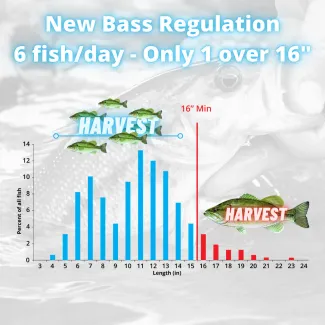Each year, the Oklahoma Department of Wildlife Conservation (ODWC) proposes changes in Title 800, the administrative rules that govern hunting, fishing and Wildlife Department operations. This year, the Wildlife Department’s Fisheries Division is proposing a rule change allowing anglers to keep smaller, more abundant largemouth and smallmouth bass, while limiting the harvest of larger bass. The proposal aims to remove the 14-inch minimum length limit from lakes and reservoirs, and would allow anglers to keep only one bass greater than 16 inches daily. If approved, biologists anticipate a positive impact on the overall quality of Oklahoma’s black bass populations.
“Catch and release has become very ingrained with bass anglers. In the most recent survey of Oklahoma anglers, 69 percent of bass anglers returned all, or nearly all, the bass they caught back to the water. The popularity of the sport combined with the cultivated practice of catch-and-release of smaller bass has impacted ODWC’s ability to increase the abundance of larger bass,” said Cliff Sager, Senior Fisheries Biologist with the Wildlife Department.
Using data from more than 100 Oklahoma lakes, fisheries biologists have found that on average, 82 percent of largemouth bass in Oklahoma lakes are shorter than 16 inches. While reduced harvest of large bass is beneficial, harvesting bass under 16 inches may improve some fisheries by reducing competition among bass, so individuals grow faster and larger.

Bass size distributions vary from water body to water body, however, this graph is typical of Oklahoma waters. The majority of largemouth and smallmouth bass are less than 16 inches long.

The intent of the proposed regulation change is to increase harvest of the smaller, more abundant fish.
With an abundance of smaller bass, there is often no need for a minimum length limit, but what about slot limits? “Most studies on slot limits show the angler still sees it as a minimum length limit, meaning they only keep fish above the slot. The current proposal addresses the problem with slot limits and encourages harvesting smaller fish”, said Josh Johnston, Northeast Region Fisheries Supervisor.
In addition to the proposed rule change, the Fisheries Division has also requested a black bass tournament exemption, which will be free to obtain. When an individual angler possesses a tournament exemption authorized by the Wildlife Department, daily bag and size limits may deviate from those listed in the Oklahoma Fishing and Hunting Regulations. Instructions for the tournament exemption application process will be provided in the Oklahoma Fishing and Hunting Regulations and on the Department’s website. If passed, the regulation proposal would allow tournament anglers to keep bass over 16 inches until weigh-in, and then the fish must be released.
The public comment period for this proposed regulation change and others will open the first week of December on the Wildlife Department's website and via written comments to the Department. Visit www.wildlifedepartment.com/public-meeting to read all the proposed rule changes and to make comments.
Largemouth Bass Size Structure 2016-2021 compiled by Fisheries Biologists around the state.
To maintain focused oversight of these species, the Wildlife Department established a Centrarchid Committee composed of 10 fisheries biologists with specialties ranging from reservoirs to hatcheries. Together, they have more than 160 years of experience in fisheries management. The Centrarchidae (sunfishes) are a family of North American native freshwater fish and include several game fish familiar to anglers, including smallmouth and largemouth bass, bluegill, and crappie. Biologists will continue to survey and monitor population trends, and develop management practices that better meet the needs and expectations of Oklahoma anglers.